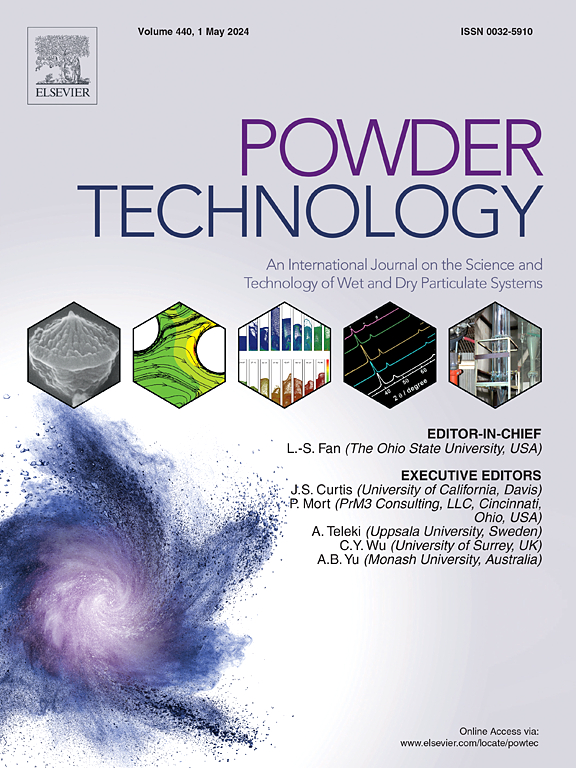An efficient and green method to separate iron from refractory iron ore by amino mineral phase transformation
IF 4.5
2区 工程技术
Q2 ENGINEERING, CHEMICAL
引用次数: 0
Abstract
Mineral phase transformation technology is an effective approach for processing complex and refractory iron resources. The reductant plays a crucial role in determining the effect of mineral phase transformation. Currently, studies on gas-based reductants mainly focus on CO and H2. However, CO as a reductant is associated with high energy consumption and greenhouse gas emissions, and H2 is difficult to store and transport, resulting in high production costs. Therefore, it is of great significance to develop and explore new reductants. In this study, NH3 was used as the reductant to study the mineral phase transformation of refractory iron ore resources under an ammonia atmosphere, and the products were processed with magnetic separation. The results indicated that a magnetic concentrate with an average iron grade of 68.21 % and an iron recovery of 91.35 % was obtained under the optimal process conditions: reaction temperature of 620 °C, reaction time of 8 min, NH3 concentration of 20 %, total gas flow rate of 500 mL/min, a magnetic separation feed fineness of −0.0375 mm accounting for 85.84 %, and 85.6 kA/m magnetic field intensity. Characterization methods including XRD, VSM, BET, XPS, and SEM-EDS were employed to assess the characteristics of products at different stages. The results showed that hematite was reduced to magnetite during the mineral phase transformation, accompanied by the formation of cracks and pores. The mineral phase transformation-magnetic separation process under an ammonia atmosphere effectively enabled the separation of iron minerals from gangue.

氨基矿物相变法从难选铁矿石中分离铁的高效绿色方法
矿物相变技术是处理复杂难选铁资源的有效途径。还原剂在决定矿物相变效果方面起着至关重要的作用。目前,气体基还原剂的研究主要集中在CO和H2上。但CO作为还原剂能耗高、温室气体排放大,且H2难以储存和运输,生产成本高。因此,开发和探索新型还原剂具有重要意义。本研究以NH3为还原剂,研究了难选铁矿石资源在氨气氛下的矿物相变,并对产物进行了磁选处理。结果表明,在反应温度为620℃,反应时间为8 min, NH3浓度为20%,总气流量为500 mL/min,磁选料细度为- 0.0375 mm占85.84%,磁场强度为85.6 kA/m的条件下,可获得平均铁品位为68.21%,铁回收率为91.35%的磁精矿。采用XRD、VSM、BET、XPS、SEM-EDS等表征方法对产物在不同阶段的特征进行评价。结果表明:赤铁矿在矿物相变过程中被还原为磁铁矿,并伴有裂纹和孔隙的形成;氨气氛下的矿物相变—磁选工艺有效地实现了铁矿物与脉石的分离。
本文章由计算机程序翻译,如有差异,请以英文原文为准。
求助全文
约1分钟内获得全文
求助全文
来源期刊

Powder Technology
工程技术-工程:化工
CiteScore
9.90
自引率
15.40%
发文量
1047
审稿时长
46 days
期刊介绍:
Powder Technology is an International Journal on the Science and Technology of Wet and Dry Particulate Systems. Powder Technology publishes papers on all aspects of the formation of particles and their characterisation and on the study of systems containing particulate solids. No limitation is imposed on the size of the particles, which may range from nanometre scale, as in pigments or aerosols, to that of mined or quarried materials. The following list of topics is not intended to be comprehensive, but rather to indicate typical subjects which fall within the scope of the journal's interests:
Formation and synthesis of particles by precipitation and other methods.
Modification of particles by agglomeration, coating, comminution and attrition.
Characterisation of the size, shape, surface area, pore structure and strength of particles and agglomerates (including the origins and effects of inter particle forces).
Packing, failure, flow and permeability of assemblies of particles.
Particle-particle interactions and suspension rheology.
Handling and processing operations such as slurry flow, fluidization, pneumatic conveying.
Interactions between particles and their environment, including delivery of particulate products to the body.
Applications of particle technology in production of pharmaceuticals, chemicals, foods, pigments, structural, and functional materials and in environmental and energy related matters.
For materials-oriented contributions we are looking for articles revealing the effect of particle/powder characteristics (size, morphology and composition, in that order) on material performance or functionality and, ideally, comparison to any industrial standard.
 求助内容:
求助内容: 应助结果提醒方式:
应助结果提醒方式:


